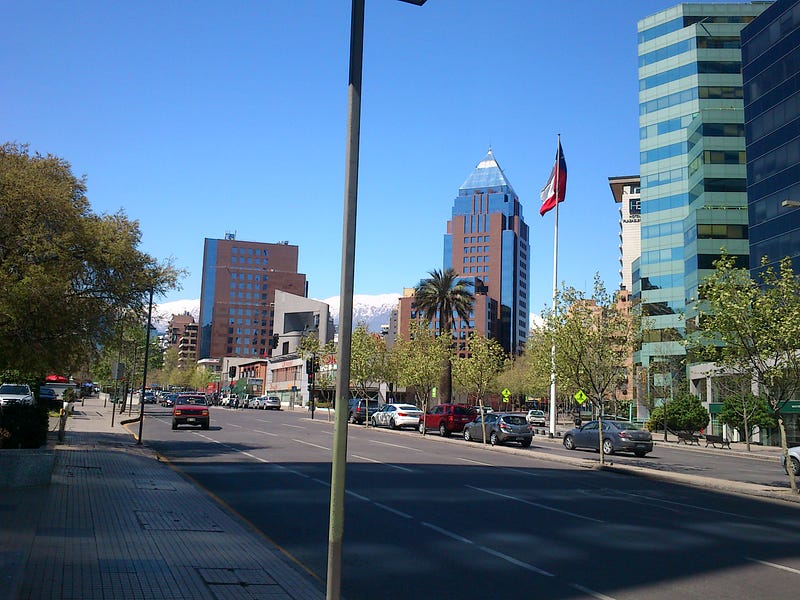We ranked the worst and the best Spanish speaking countries to visit (other than Spain). Here is it.
PS: After reading this interesting article about Spanish speaking countries to visit, check also our Youtube channel.
During my career in the transportation and tourism industry (a career that now spans over more than a decade), I was lucky to travel to over 50 countries.
Many of those were Spanish speaking – something convenient for me since it is one of the languages that I am fluent in.
And maybe it is exactly the language one of the reasons why so many people look specifically for countries that speak Spanish when planning holidays.
But the familiar official language and familiar language is not the only attraction that the former colonies of the Spanish empire have to offer. From Machu Picchu to Chichen Itza and Mayan ruins, from the Andes mountains to the Caribbean sea and some of the most beautiful beaches on the planet, traveling to a Spanish-speaking country means natural beauty at the touch of your hands.
All that while you can put your language skills to work and improve your Spanish.
In this rank we didn’t include Spain since it is already covered by many other pieces we published, and Puerto Rico, which is not really a country.
But before we jump to the list, it is important to revise the criteria that we used to rank the top Spanish-speaking travel destinations.
The Criteria to Rank the Best Spanish-Speaking Countries to Visit
We used 4 factors to rank the best Spanish-speaking countries for your next vacation.
1st – The number of international tourists each country receives per year.
The number of international tourist arrivals per year is a good proxy statistic to measure the touristic infrastructure and attractiveness of a country because it is a measure of how many people are interested in visiting a country.
- It is a measure of demand: The number of tourist arrivals is a measure of how many people want to visit a country. If a country receives millions of visitors every month, it is likely a nice place to visit (unless it is really overcrowded).
- It is a measure of supply: This is a good indicator of the availability of tourism attractions and services (like hotels and transportation) in a country.
- It is a measure of satisfaction: The number of tourist arrivals is also a measure of the satisfaction of tourists with their experience, especially when we consider recurring travelers (those that come back after their first visit).
While there are exceptions to this rule, a higher number of international tourist arrivals indicates that a country has a more developed tourist infrastructure and is more attractive to tourists.

2nd – The Numbeo Cost Index
The Numbeo cost index is a tool that helps travelers compare the cost of living in different cities around the world. The index is based on a survey of prices for goods and services in different cities, and it is updated regularly.
The Numbeo cost of living index is useful for travelers because it can help them to budget for their trip. By knowing how much things cost in their destination city, travelers can avoid overspending. The index can also help travelers choose a city that is within their budget.
The index uses as a basis the costs of New York City in the US, which has a baseline number of 100. So if a given nation or city has an index of 50, it means its prices are in average 50% of the price you would expect in New York.
Talking about costs, we have 2 very good articles for anyone interested in saving money while traveling: one is about the cheapest cities to fly into Europe and the other is about 3 inexpensive (but wonderful) cities to visit in Europe during winter.
3rd – The Homicide Rate
The homicide rate (sourced from Statista) is a good proxy statistic to measure violence because it is a relatively easy statistic to collect and it is a good indicator of the overall level of violence in a country. It is represented by the number of homicides per 100,000 people in a country.
While there are exceptions (eg: countries that have a very high number of assaults or burglaries but almost no homicides), in general, a higher homicide rate indicates that a country is more violent.
And let’s admit: nobody wants to spend holidays worrying about safety.
If you want to know some really dangerous cities, check our articles about the most dangerous cities in Europe and about the most violent city in each of these 18 European countries.
Table with all the data collected
| Country | International Tourists (2022) – in millions | Numbeo Cost Index | Homicide Rate (2022) |
| Mexico | 39.6 | 52.78 | 29 |
| Argentina | 7.6 | 59.43 | 5.3 |
| Dominican Republic | 7.4 | 49.59 | 12.2 |
| Chile | 7.2 | 57.34 | 3.5 |
| Colombia | 4.5 | 54.25 | 24.9 |
| Peru | 4.5 | 51.31 | 20 |
| Cuba | 4.2 | 50.16 | 5.2 |
| Costa Rica | 3.1 | 52.55 | 10.7 |
| Uruguay | 2.9 | 52.83 | 7.5 |
| Venezuela | 2.9 | 69.85 | 56.3 |
| Panama | 2.8 | 54.55 | 19 |
| Ecuador | 2.7 | 51.93 | 5.5 |
| El Salvador | 2.5 | 50.06 | 16.3 |
| Guatemala | 2.5 | 51.03 | 27.4 |
| Honduras | 2.3 | 50.73 | 42.8 |
| Nicaragua | 1.7 | 50.44 | 11.5 |
| Bolivia | 1.3 | 51.57 | 6.6 |
| Paraguay | 1.1 | 48.48 | 11.5 |
| Equatorial Guinea | 0.1 | 64.41 | 10.2 |
4th – The Personal Opinion of the Author After Travelling to These Countries
I had been to the majority of the countries ranked below. While numbers, statistics, and other factual data are often useful to paint a general scenario of a certain holiday, human reviews are still important.
That is why we often check the opinions of other guests and customers when selecting a hotel, for example.
Of course, my opinion is not the most important factor here, but only one of the 4 that compose this entire analysis, and I am open to any criticism or disagreement (feel free to write it in the comment section).
And talking about personal opinions, check later this article about the most (and the LEAST) beautiful European capitals.
The Worst Spanish-Speaking Country to Visit in 2023: Venezuela

Check the third column in the table a few paragraphs above. A generally acceptable number there is below 20. A desirable number would be in the single-digit.
But pay attention to the whooping value for Venezuela.
This once rich and prosperous South American country is now one of the most violent in the entire world.
Venezuela is violent. It became so dangerous that the number of murders and kidnaps in this country would make war zones look peaceful.
Still, even violent countries like Mexico manage to keep relatively peaceful zones that are attractive for international travelers (the touristic hotspots of Mexico are way safer than the rest of the country, except for Acapulco).
But this is not the case in Venezuela. If the enormous violence was not enough, the country went downhill in many other aspects.
The infrastructure in Venezuela is also in a state of decay. The country’s roads, bridges, and airports are in poor condition. There are also frequent power outages and water shortages. The decaying infrastructure makes it difficult to get around Venezuela and to access basic necessities.
In addition to the high homicide rate and decaying infrastructure, there are other reasons why Venezuela is a bad place to visit. Currency controls, for example, make it difficult to change back to US dollar any Bolivar that you didn’t use during your trip.
The 7 Best Spanish-Speaking Countries to Visit
7th – The Dominican Republic
Number of international tourists per year: 7.4 million
Reasons why the Dominican Republic deserves a place in this ranking:
- Beautiful beaches: The Dominican Republic has some of the most beautiful beaches on the continent. I had been to the white-sand beaches of Punta Cana, and it is really world-class (that explains why so many wealthy pensioners often chose this place).
- Friendly people: Dominicans are known for their warm hospitality and friendly smiles. You will be welcomed with open arms wherever you go.
- Affordable prices if you are traveling with a family: The Dominican Republic is a very affordable travel destination for families. Local resorts have special packages for couples with kids, and the little ones will have plenty of entertainment. It is also a great honeymoon destination.
In addition to all of these reasons, the Dominican Republic also has a unique Spanish dialect that is worth experiencing. Dominican Spanish is known for its fast pace and its use of slang. If you are a Spanish speaker, you will have a lot of fun trying to understand the locals.
If you are looking for a beautiful, friendly, and well-connected by-air destination, the Dominican Republic is a great option.
6th – El Salvador
Number of international tourists per year: 2.5 million
Despite its turbulent history and decades of civil war (something already on the past), El Salvador has made significant strides in recent years to enhance its tourism sector and attract visitors from around the world.
Notably, El Salvador has experienced a significant decrease in violence over the past two years. This positive trend has contributed to creating a safer environment for both residents and visitors, allowing tourists to explore the country’s attractions with a greater sense of security. We wrote an entire article about the fantastic decrease in criminality in El Salvador.
One of the primary reasons to visit El Salvador is its stunning natural landscapes. The country is blessed with picturesque beaches along its Pacific coastline, which is renowned among surfers for their consistent waves.
Inland, the country offers lush national parks like El Imposible, providing opportunities for wildlife encounters and nature enthusiasts.
El Salvador’s rich cultural heritage is another compelling reason to explore the country. Its charming colonial towns, such as Suchitoto and Concepcion de Ataco, offer visitors a glimpse into the nation’s history, with well-preserved architecture, cobblestone streets, and colorful houses.
El Salvador has its own distinct Spanish dialect, known as Salvadoran Spanish. Compared to some other Spanish-speaking countries, Salvadoran Spanish is considered relatively straightforward and easy to understand for learners, making it an ideal place for language enthusiasts to practice their Spanish skills.
5th – Peru
Number of international tourists per year: 4.5 million
One of the main draws of Peru is its archaeological treasures, notably the legendary Machu Picchu. This ancient Inca citadel nestled in the Andes Mountains is a UNESCO World Heritage site and one of the World’s New Seven Wonders.
Despite having a gorgeous coastline, the amount of cultural attractions in Peru makes it one of the great destinations for people that hate beaches.
Peru’s cities also offer a unique charm.
- Lima, the capital, showcases a fusion of colonial architecture, modern skyscrapers, and a vibrant culinary scene. The Peruvian capital has Michelin-star restaurants enough to rival any European capital.
- Cusco, the gateway to Machu Picchu, boasts cobblestone streets, Inca ruins, and a lively atmosphere.
- Other cities like Arequipa and Trujillo feature stunning colonial architecture and historical sites that highlight Peru’s rich past.
- If you are a surfer, a must-see is the wavy, sandy beaches situated just south of Máncora.
The Peruvian accent is generally considered clear and easy to understand, making it favorable for language learners. Peruvians are also known for their friendly and warm approach, making interactions with locals a delightful experience.
4th – Chile
Number of international tourists per year: 7.2 million

One of the main reasons to visit Chile is its breathtaking natural landscapes, from Patagonia in the south to the Atacama Desert in the north. It is also tops the list of the best countries to live in Latin America, and that says something.
Additionally, Chile boasts the awe-inspiring Torres del Paine National Park in Patagonia, with its majestic mountains, glaciers, and turquoise lakes. The country also offers a diverse range of outdoor activities, including hiking and skiing (I learned to ski there, in the resort of El Colorado, very close to the capital Santiago).
Since many of our readers wanted to know more about this country, we wrote an entire article about living in Chile. But now, let’s open space for some polemics: if you are still in the first stages of learning Spanish, maybe Chile is not the best place for you. Not at least to practice your Spanish.
Chilean Spanish is characterized by its rapid speech, unique pronunciation, and a variety of local slang words and expressions. Chileans often use distinctive vocabulary and pronunciation, making their Spanish dialect, not the easiest to understand. For example, they tend to drop the final “s” in words and use specific idiomatic phrases.
3rd – Costa Rica
Number of international tourists per year: 3.1 million
Probably there is no country in the world that mastered the art of harnessing tourism for beneficial purposes while conserving its natural landscape like them. Yes, in this matter, Costa Rica is really an example to be followed.
In addition to its natural beauty and language, Costa Rica is committed to sustainable tourism and conservation. The country has dedicated a significant portion of its land to protected areas, ensuring the preservation of its unique ecosystems. Visitors have the opportunity to engage in eco-friendly activities, such as rainforest hikes, wildlife tours, and educational experiences that promote environmental awareness.
Costa Rica also became a place to go for digital nomads due to the low costs.
Costa Ricans, commonly referred to as “Ticos,” have a friendly and welcoming nature, and their Spanish dialect reflects that. Tico Spanish is characterized by a gentle and melodic rhythm, with a tendency to use diminutives and colloquial expressions. Compared to other Spanish-speaking countries it is generally considered clear and easy to understand for learners.
2nd – Mexico
Number of international tourists per year: 39.6 million.

Mexico is one of the most visited countries in the world. That statement is self-explanatory when we debate how attractive is this country for your next holidays.
Since in this ranking we are not considering Spain, likely many readers would expect Mexico to top the list, so instead of writing about all the obvious strong points of Mexico as a popular travel destination, we will explain why it took the 2nd, and not the first place.
In the most touristy zones of Mexico, likely will not hear much of the Spanish language. You can have a great time visiting Cancun, Tulum, or the ancient Mayan ruins in the middle of the jungle but it is not the best place to practice your language skills. Mexico also attracts expatriates willing to retire abroad, especially from the US.
That was my experience at least. Since every service in the hotel zone of Cancun is targeted at American and other foreign tourists, nearly everyone speaks English and most things are written in English.
Additionally, due to its proximity to the US, Mexico is not really a cheap place to visit during the high season – especially if we compare Mexico versus the first place in this ranking, which is incredibly inexpensive.
Concerning safety, Mexico has had its share of security challenges in certain areas (we wrote about the Mexican murder capitals here), particularly near the border. However, popular tourist destinations and cities that heavily rely on tourism, such as Cancun, Playa del Carmen, and Los Cabos, have well-established security measures in place, making them relatively safe for travelers. These areas often have a significant police presence and prioritize the safety of visitors.
The Best Spanish-Speaking Country to Visit in 2023: Argentina
Number of international tourists per year: 7.6 million per year.

Stunning landscapes, epic architecture in the capital Buenos Aires, and some seriously delicious food. From the mind-blowing glaciers in Patagonia to the insane Iguazu Falls (I spent part of my honeymoon there!), this country (once an escape for war criminals) will leave you speechless.
And I say that as a Brazilian (we were supposed to have some rivalry with our Argentinian neighbors, but I will not deny that their country is gorgeous).
The food, the landscape, the culture… all that would be enough to put Argentina in this top 7.
But here is what really raised them to the 1st place: it is ridiculously cheap to visit Argentina right now. Their currency is very devaluated against the dollar or euro.

Due to the devaluation of the Argentine peso, the country and its capital Buenos Aires have become incredibly affordable destinations for international travelers. With the exchange rate favoring foreign currencies, visitors can enjoy excellent value for their money.
This means that accommodation, dining, transportation, and entertainment can be more budget-friendly compared to other destinations. It is your chance to stay in a 4* star hotel for the price of a hostel bed in Europe.
Argentina is a huge country and therefore has multiple dialects. In the capital Buenos Aires, it is characterized by its unique pronunciation and vocabulary, influenced by Italian and European immigrants who settled there. Meanwhile, in areas like Misiones, it carries indigenous influences.

If you enjoyed this article about travel spots where Spanish is the official language, here are a few other reading suggestions for you:
The 7 Countries With The Worst Work-Life Balance in The OECD
The Best Cities for Remote Workers in 2023
Levi Borba is the founder of The Expatriate Consultancy, creator of the channel The Expat, and best-selling author. Some of the links in this article may be affiliate links, meaning that the author will have a commission for any transactions.




